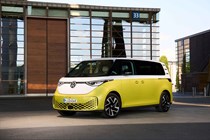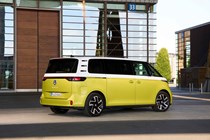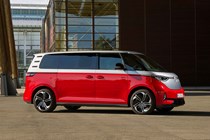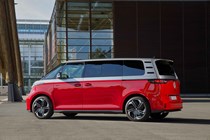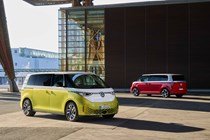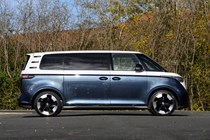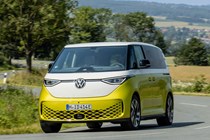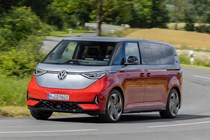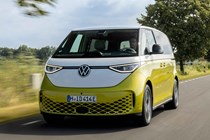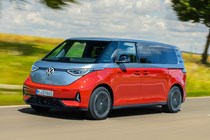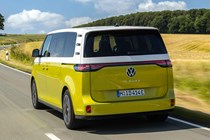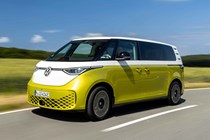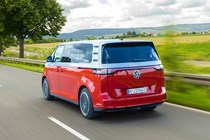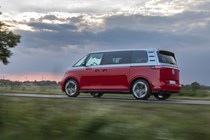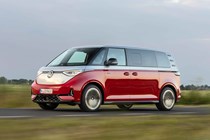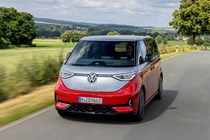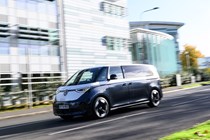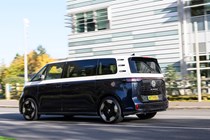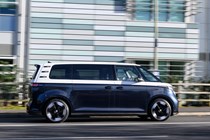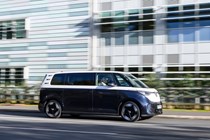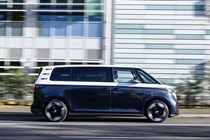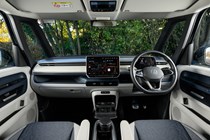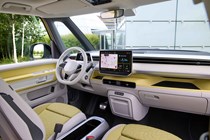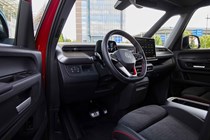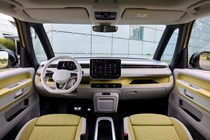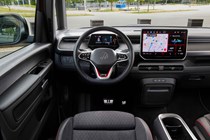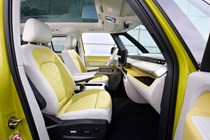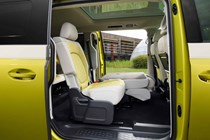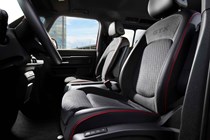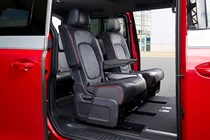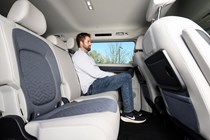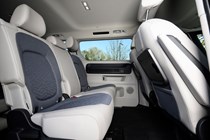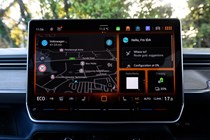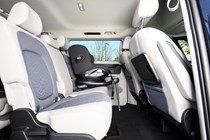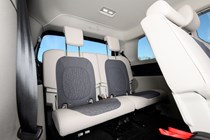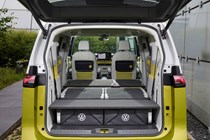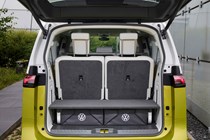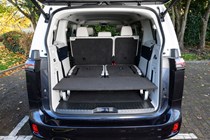
Volkswagen ID. Buzz long-term test
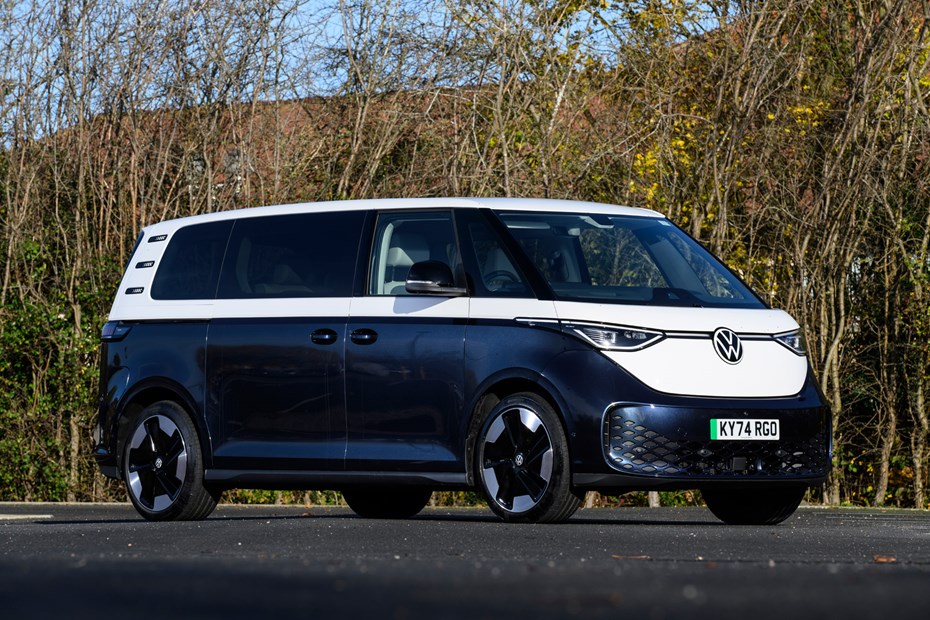
We’ve been waiting decades for an electrified reboot of the old rear-engined VW vans, can the Volkswagen ID.Buzz live up to the hype? We’re living with a top-spec Style for six months to see how it handles family life.
Reports by Alan Taylor-Jones
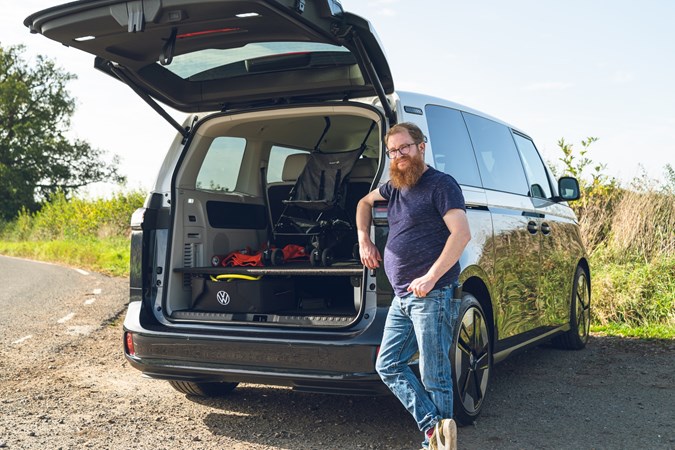
Jump to:
- Update 2: Space isn’t everything
- Update 3: Drive to surprise
- Update 4: Range and charging
- Update 5: A better alternative?
- Update 6: The verdict
Update 1: Welcome to the fleet
Introducing the Volkswagen ID.Buzz Style SWB 77kWh Pro
Over the next six months, we’re going to be living with a top-spec VW ID.Buzz to see just how good it is. After all, you can draw a few conclusions from a few hours or days behind the wheel, but an extended test really lets you get under the skin of a car, or indeed van.
That’s right, despite sitting on VW’s MEB platform that also underpins the ID.3 hatchback and ID.4 SUV, the ID.Buzz is sold through the brand’s commercial vehicles arm. It’s the same story with the Multivan MPV and Transporter minibus, though.
At the time of delivery there was only one choice of battery and motor for the Buzz; a 77kWh and 204hp. Similarly, there was only the short-wheelbase five-seater bodystyle, with a longer seven seat model on the horizon. Like other VW ID products, expect more power and a longer range in 2024.
Picking your ideal Buzz is made even easier by a mercifully simple trim lineup. There’s entry-level (but still well-equipped) Life or top spec Style and I’ve gone for the latter. You’ll be spending nearly £5,000 for the privilege, but for that you get a few key upgrades that make it worthwhile.
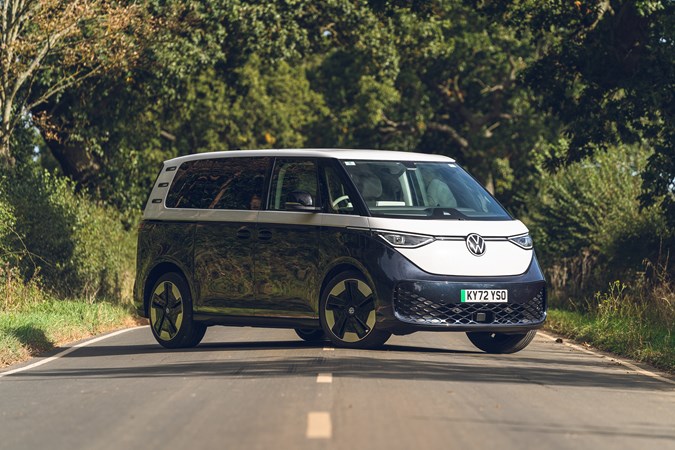
Standard equipment for Life includes:
- 10.0-inch infotainment system with smartphone mirroring and nav
- Two-zone climate control
- Adaptive cruise control
- Heated front seats, steering wheel and windscreen
- Front and rear parking sensors with a reversing camera
With the key equipment Style adds being:
- Adaptive LED headlights
- Dual armrests for both front seats
- Multi-flex boot separator
- Gesture controlled power tailgate
- More exterior lighting
Then there’s the small matter of options. Despite costing nearly £64,000 before you’ve added anything, I’ve managed to bring the total spend to just over £72,000. That’s split into:
- Two-tone paint (£2,790)
- Infotainment package plus (£1,560)
- Comfort Seat Package – ArtVelours (£2,305)
- Retractable towbar (£980)
- 21-inch alloy wheels (£515)
- Type 2 charging cable (£190)
You could argue that the two-tone paint is an unnecessary extravagance, but that and the 21-inch wheels make the most of the concept car styling. A Type 2 cable is a necessity in my book, while the larger screen the infotainment package plus brings should make it easier to control.
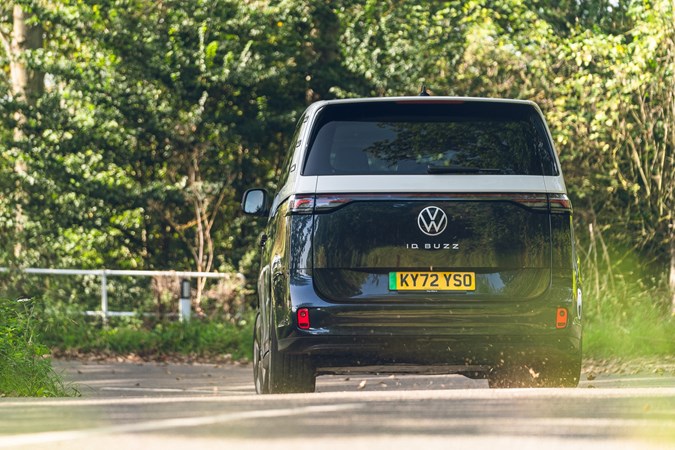
As for the towbar, I figured it could be handy for the odd tip run rather than mess up the interior, although I’d have to buy a trailer first. Finally the seats are both a sensible and terrible idea. The pricey pack adds memory electric seats which make sharing a car with someone else so much easier.
There’s also a massage function which is a bonus, but the light-coloured velour seats may be somewhat incompatible with a toddler. That’s not something that can be said about the boot which is ludicrously big.
As many parents out there will know, buggies and prams can be exceptionally bulky and tend to not want to fold at the worst possible time. Even with the multi-flex false boot floor in place I can still perch an unfolded buggy in with space to spare for the various bags, toys and other accessories that come with a small person.
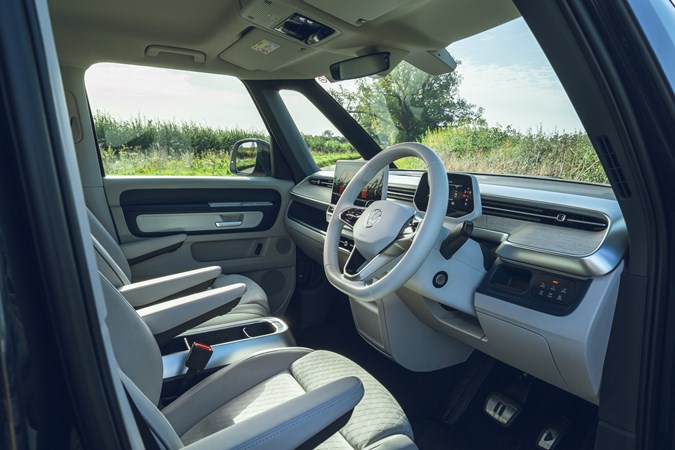
It’s a bit of a shame the interior isn’t a bit more flexible, though. I’ll cover this in plenty of detail in a future report, but the seats don’t really do anything that clever, even compared to VW’s own Multivan. We’d also expect more than two Isofix mounts.
As for the driving experience, it feels a little quicker than its 10.2 second 0-62mph time would suggest most of the time. There’s certainly enough punch not to be disgraced and the traffic lights although an A or B road overtake does require some planning. It also handles far better than you’d expect and is mostly comfortable despite the giant wheels.
My biggest concern is range. According to official figures it’ll do 255 miles on a single charge, although so far, I’ve got nowhere near that. Show it a motorway and drive at the speed limit and you’ll chew through the battery in less than 200 miles. Here’s hoping I can eke out a little more moving forward.
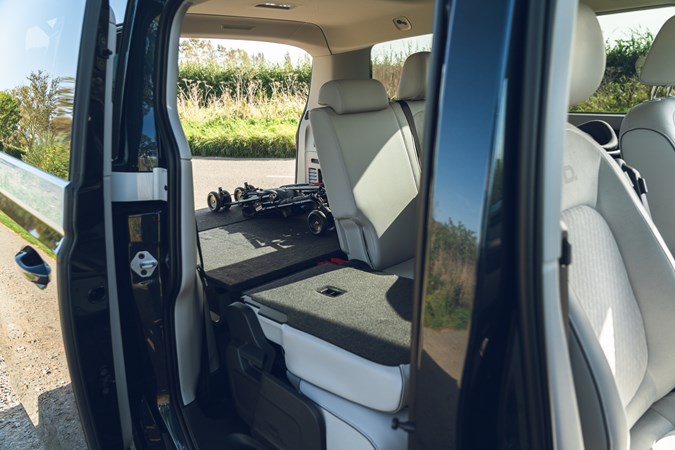
Update 2: Space isn’t everything
At first glance, you’d think the ID.Buzz was massive. It’s tall for a start, and those slab sides help emphasise its not inconsiderable width. The truth is that it’s around the same length as a Tiguan Allspace albeit around 10cm wider and a substantial 30cm taller.
All that helps the cabin feel more like a room than a car interior. Even with its tall driving position, headroom is exceedingly generous and there’s plenty of legroom front and rear. The Buzz’s generous width also means there’s plenty of room for three across the rear bench.
It’s handy that it can be slid back and forth in the unlikely event that you need more boot space, and the recline feature is good, too. Even so, this feels like a massive missed opportunity. Cheaper van-based electric MPVs such as the Citroen e-Berlingo and Peugeot e-Rifter come with three individual rear seats each with Isofix child seat mounts. Meanwhile the Buzz’s central seat isn’t shaped for bottoms and there’s no Isofix for it, either.
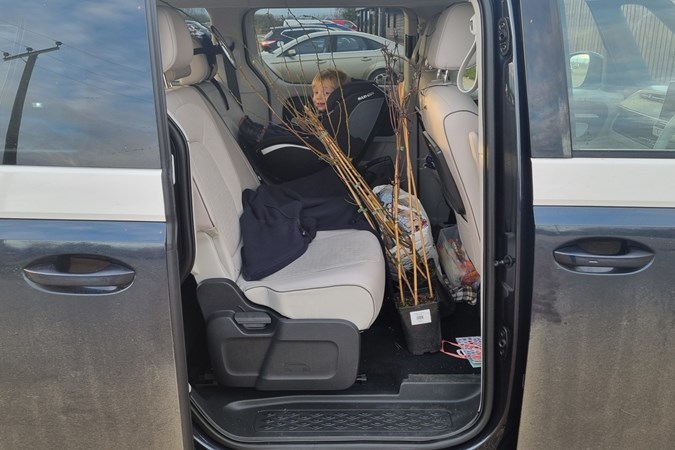
With no Isofix up front either, it makes what should be a perfect child hauler slightly compromised. It’s a shame as the boot swallows even the largest pushchair, frequently without having to fold it up in the first place even with the false floor present.
I haven’t tried taking it out yet, partially because it’s a very useful way to separate loads, but mainly because it consists of two steel-legged carpeted benches. They’re pretty heavy and would take up an awful lot of space in my garage, space currently filled with myriad kitchen cabinets.
You can fold the rear seats down in a standard 60/40 split, but I’ve not had to so far. That said, an upcoming week off with a few DIY tasks might change that. One thing I won’t be doing is removing the rear seats which astonishingly can’t be removed entirely. Although it’s not something I’d be doing regularly, I should imagine it’d make life a lot easier for cycle enthusiasts, for instance.
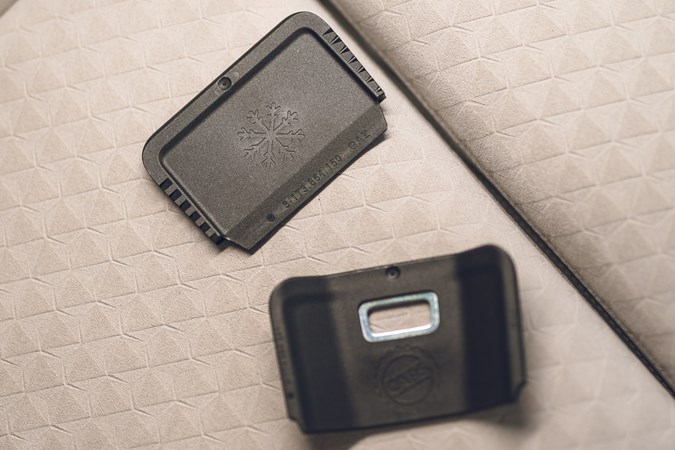
You won’t hear me complaining about storage up front, though. Cupholders that fold out of the lower dash free up the removable centre console for all manner of detritus. Baby bottles, toys, keys and plenty more fits, and the cubby is deep enough to ensure nothing should fall out.
There are a couple of dividers should you not want one long tray, and they serve a double purpose. One is an ice scraper, not something we’ve had to use thanks to the Buzz’s preconditioning, and the other a bottle opener. If only the whole van had this level of attention to detail applied to it.
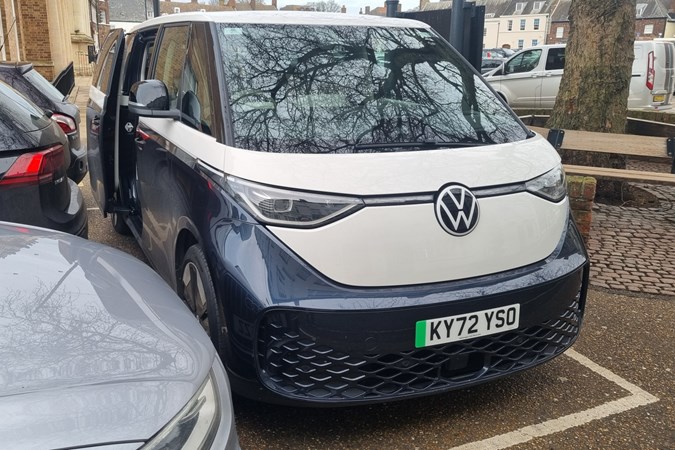
While I’ve had no issues finding spaces long enough for the Buzz, finding them wide enough is more of an issue. At least the sliding rear doors mean you can squeeze it into gaps that wouldn’t allow you to open the fronts, although annoyingly they don’t always latch fully open. The optional electric doors are well worth considering. I’d also point out that the huge rear hatch needs quite a bit of space to swing up, and if you’ve misjudged it, requires a firm hand to stop it manually.
A rear camera is standard equipment, with a surround view system optional. Ours has the former, which is OK but could do with a higher resolution and some sort of cleaning device. The surround system is worth considering, as the stubby nose and high driving position can make it tricky to place at first.
Despite these frustrations, I am warming to the Buzz. Not having to worry if we’ve enough space in the car is liberating, and it’s a largely relaxing thing to drive. Range has nosedived somewhat in the winter months though, something I’ll cover in the next update.
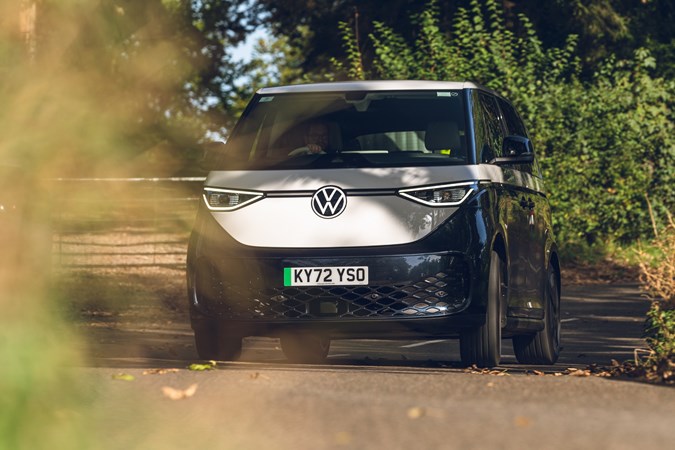
Update 3: Drive to surprise
While I wouldn’t call it a wolf in sheep’s clothing, the ID.Buzz has proved capable of surprising both driver and surrounding traffic on numerous occasions. A double-digit 0-62mph time looks glacial in this day and age, but it just doesn’t tell the whole story.
The Buzz does its best work at lower speeds, taking off from a standing start far faster than a 10.4 second 0-62mph time would suggest. Traction is never an issue, and the responsiveness of the electric motor means you rarely lose at the lights around town.
It’s on faster A roads that I usually find myself craving the newer 282hp motor that’s found in the ID.7 saloon or the upcoming twin-motor ID.Buzz GTX. Living in Norfolk and working in Peterborough or further west means I spend a lot of time on the A47, a road that’s chock full of HGVs, tractors and other farm machinery.
With much of the A47 being single carriageway, I appreciate something that’s able to get up to the national speed limit or just beyond in very short order. While an ID.3 with the same 204hp motor is perfectly acceptable, the Buzz leaves me on the wrong side of the road for a bit longer than I’d really like, even with just me in the van.
That said, I am comparing the acceleration of something that Volkswagen classifies as a van to a hatchback. If you’ve jumped out of most other commercial vehicles, the Buzz is almost certain to feel quite brisk.
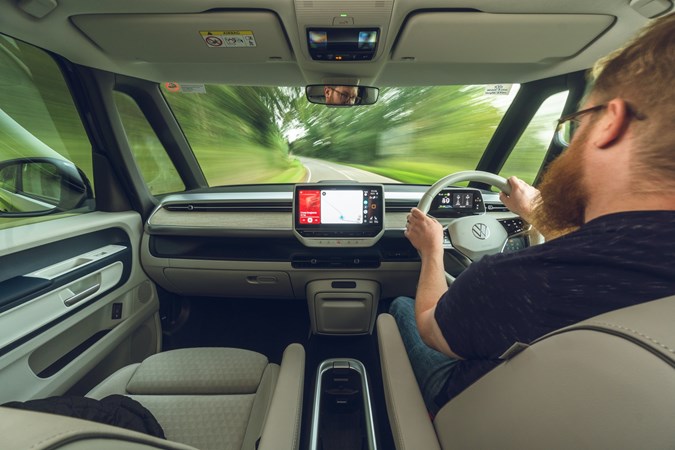
But we’ve come to expect EVs to accelerate comparatively quickly, the real surprise is how well the Buzz corners. Now, at over two tonnes and nearly two metres tall, it’s never going to feel like a sports car, yet it proves far more capable and enjoyable than you’d imagine.
Because the heavy battery pack lays flat under the floor, the centre of gravity is low, which means the wide tyres can grip and grip without the stability control having a fit thinking you’re going to roll over. Generally, I’m only aware of the electronics having to intervene if I have to clog it out of a busy T junction, with any wheelspin quickly quashed without significantly slowing your forward progress.
If you’re at all worried the rear-wheel drive layout might result in unwanted sideways moments, the electronics ensure you’ll feel only the slightest shuffle from the back before order is restored. I suspect many won’t even get to this point such is the grip available, and there’s no ESC Sport mode or off button to investigate further. It’s probably for the best, although I do wonder how the Buzz would get on in those few slippery situations where a bit of wheelspin can help.
Body roll is certainly noticeable, but there’s much less of it than you’d expect from something so tall, so it never feels worrisome. The steering is precise, well-weighted and feels appropriately geared; you’re certainly not twirling the wheel repeatedly to get around bends, but neither does it feel too quick and therefore nervous.
Ride comfort does suffer somewhat to make the Buzz handle so well, although the optional 21-inch wheels are partially to blame here. There’s always a slight underlying fidget to the ride, while the at low speeds the Buzz can make poorly surfaced roads feel worse than they actually are.
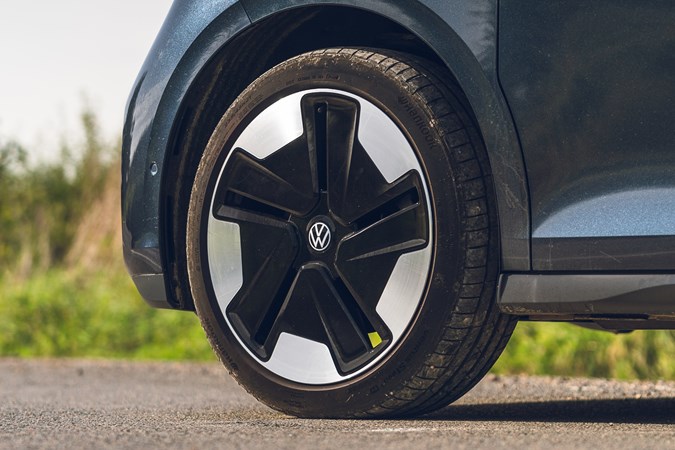
We’d stick to the standard wheels as they should improve comfort and also be a lot harder to kerb. As it stands, at least two of the wheels are concrete rather than diamond turned around their outer edge. The width of the Buzz doesn’t help, and nor do the slightly stretched looking tyres that don’t offer as much protection as I’d like.
One of the Buzz’s biggest annoyances is just how nannying it can be. The first 30 seconds of any journey is spent turning off the speed limit warning and lane keep assist, something that requires a prod of a shortcut icon and then several screen presses in the driver assist menu. I appreciate the icon, but plenty of manufacturers including Land Rover do it better.
To be fair, the lane assist isn’t as annoying as the system fitted to the BYD Atto 3 we ran last year, but still can’t understand why I might want to drive nearer the centre of the road on narrow country roads with overgrown verges. As for the speed warning, there are a number of places where it’s just too sluggish to keep up, telling you to slow down when you’ve already entered a higher limit.
This pales into insignificance if you just want to move the Buzz without putting your seatbelt on. Let’s say I need to shuffle it over a bit on my drive to make way for a visitor. Instead of just jumping in, selecting a gear and going, the sensor on the driver’s seat has to feel my bottom in a very particular spot otherwise it’ll just throw it in park before I’ve even started moving.
I’ve tried manually starting it, but even then, it’s far too keen to stop me driving leading to severe frustration. Yes, I could (and often have to) just stick my seatbelt on, but it’s a pain when you’re literally moving the thing three feet at less than 5mph.
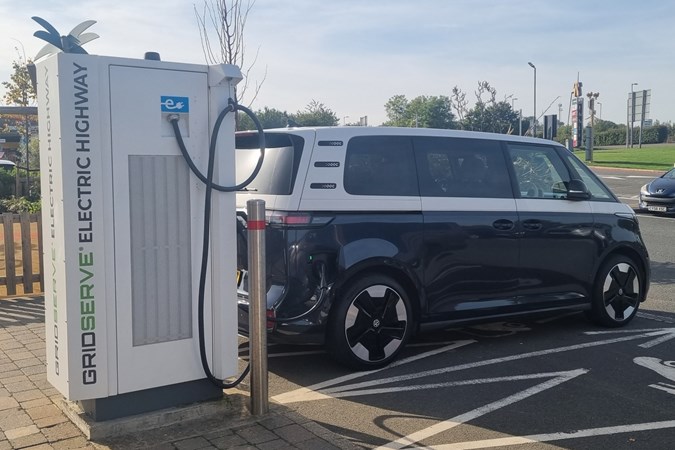
Update 4: Range and charging
For many, an electric car’s range is a huge factor in whether they pick it or not. Volkswagen certainly has form in producing efficient EVs, with some testing carried out for our sister site CAR showing impressive numbers from the latest ID.3 hatchback and ID.7 executive car.
However, these are both much lower and less shed shaped than the Buzz. Where its smaller siblings pass cleanly through the air, the Buzz’s motors must work much harder at speed, hurting efficiency. With both my wife’s and my commutes taking in a fair bit of dual carriageway and 60mph roads, albeit with a bit of urban crawl thrown in, we’ve still not seen more than 195 miles on a full charge.
I shouldn’t have been too surprised as that figure was managed during summer, and much of our time with the Buzz has been in the depths of winter. Range has tumbled even further, although that’s partially my fault for setting the cabin to preheat. It’s one of my favourite features of an EV, ensuring that you’ll never wake up to a cold, icy car that requires five or ten minutes of shivering scraping.
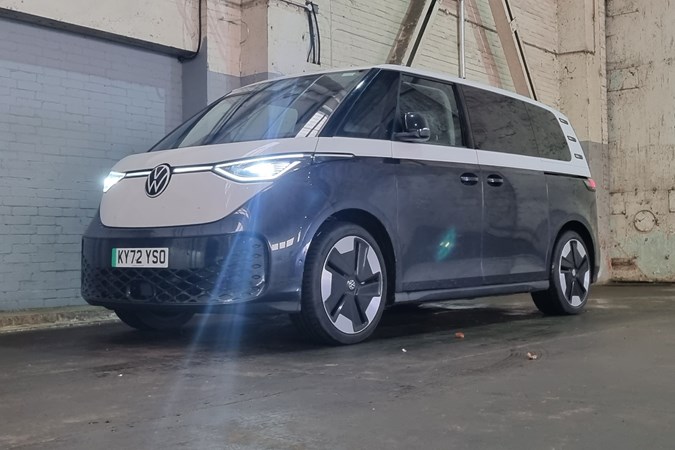
It’s no problem when it’s plugged in, but leaving the Buzz unplugged and preheating does knock a few miles of range off the battery. We have found the range indicator has generally been very reliable, save for a couple of occasions where returning to the car on particularly cold days revealed a shorter range than expected.
This has caused a couple of will it/won’t it journeys, but the Buzz does leave you a little in reserve even when it says it won’t go any farther. We’ve therefore never been stranded, always getting home or to a rapid charger before the Buzz completely conked out. Crucially, it doesn’t limit power to the same degree as the BYD Atto 3 we ran previously, meaning you’re not a mobile chicane once the battery is nearly flat.
Although more range would be welcome, we’ve no complaints regarding the rapid charge abilities of the Buzz. A peak rating of 170kW means the 77kWh battery can get from 5-80% in around 30 minutes on a punchy enough charger. Considering that’s a fairly normal and frequent rest stop when small children are involved, it does help make longer journeys less painful.
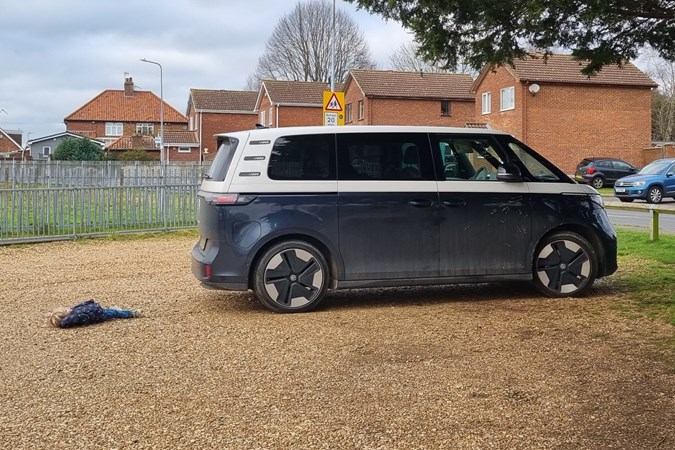
Even so, I’d recommend waiting for the updated ID.Buzz that’s due later this year. Battery size increases to a more useful 91kWh bringing much needed range, and there’s a new motor, too. This is more efficient, while a boost from 204hp to 282hp will make the acceleration far livelier.
However, while range will undoubtedly improve, I wouldn’t expect a huge boost in efficiency due to the Buzz’s stubby shape. Over the course of our loan, we’ve averaged 2.4 miles per kWh – about right for an electric van but way behind the four miles per kWh plus of lower, sleeker rivals.

Update 5 – A better alternative?
Arguably one of the ID.Buzz’s biggest threats comes from within Volkswagen itself. For significantly less than the price of an entry-level Buzz you can get your hands on a Multivan, a combined replacement for the old Sharan MPV and the outgoing Caravelle.
Unlike the Buzz, this isn’t an EV. Instead, there’s a choice of petrol, diesel or plug-in hybrid power. As we’ve got a home wallbox, it’s the PHEV we borrowed in plush Style specification. It’s got about the same power as the Buzz, is similarly lofty and a little longer, but isn’t quite as wide, making it instantly feel more compact and easier to thread through the gateway to my drive.
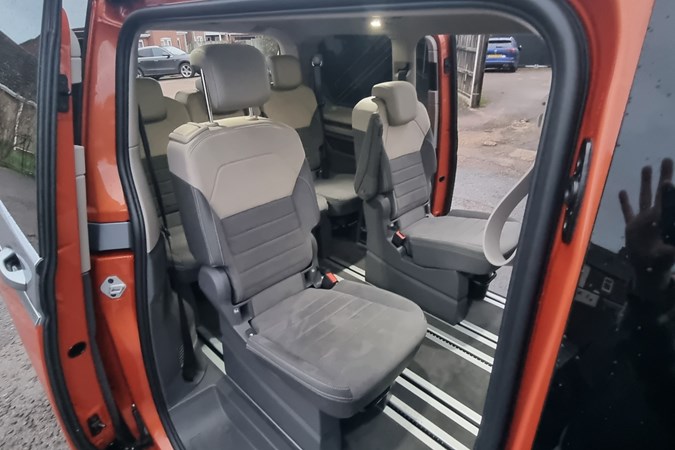
Where the Multivan really scores is in its capacity for people. With a Buzz you’ll need one of the upcoming long wheelbase models to gain seven seats where all Multivans seat seven as standard. Given that the shortest Multivan is only around 20cm longer than the Buzz, it’s quite the achievement.
Naturally, there is a penalty for this. The short wheelbase Multivan hasn’t got a massive boot with all seats in place, although there’s enough room for a stick buggy on top of the parcel shelf and a reasonable amount of shopping below it. Unlike the Buzz, you can remove the seats entirely should you actually need a van.
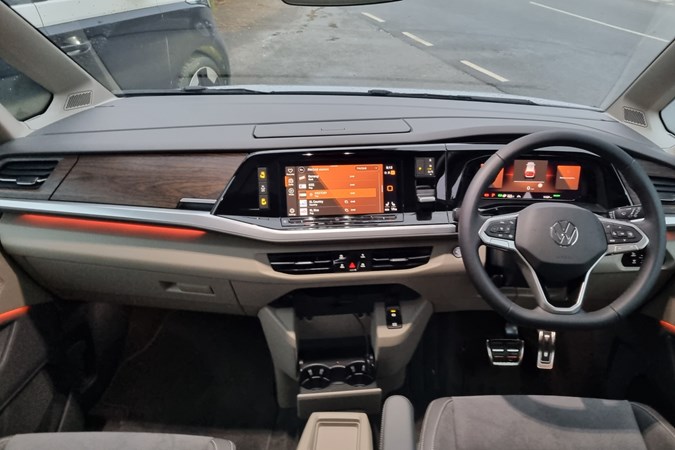
Despite appearances, the Multivan isn’t really a van underneath. Like the Buzz, it sits on a platform designed primarily for cars – in this case the one that underpins the Volkswagen Golf, Seat Leon and Skoda Octavia. It therefore drives in a more car-like fashion than the Caravelle, its Transporter van-based predecessor.
You don’t sit quite so upright for a start, and the suspension is more supple than the old Caravelle and our Buzz, too. Despite its comfort, it also goes around corners tidily, if not quite as keenly as the Buzz. The PHEV system is well suited, too. There’s ample power, especially with both power sources working, and you’ll get over 20 miles of electric range in the real world.
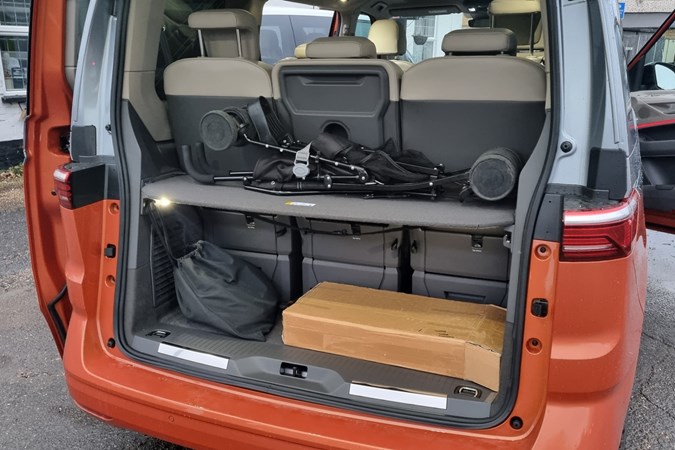
Admittedly, this EV range is a little disappointing compared to a lot of modern plug-in hybrids, although once again we’ve got aerodynamics to thank for that. This also means company car BIK rates aren’t as low as they could be, although they still undercut the petrol and diesel models by a chunky margin.
However, if you’re buying privately we’d still be very tempted by the good old-fashioned diesel model. It’s not as fast as the PHEV or top petrol Multivan, but it’s flexible, fast enough and significantly cheaper than the plug-in and certainly the ID.Buzz.
The whole experience left me feeling more than a little jealous of CJ Hubbard, who previously ran a Multivan long-termer. Follow the handily place link to read about six-months with that.
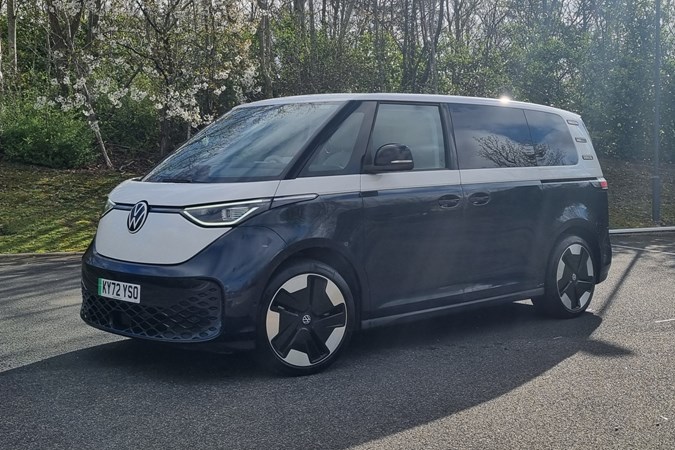
Update 6 – The verdict
After six months of family use, it’s time to wave goodbye to the Volkswagen ID.Buzz. It’s something that should have fitted into our lives perfectly but left both my wife and I somewhat disappointed.
I had braced myself for the limited range, and to be honest it was rarely an issue. The battery’s 77kWh size meant an overnight charge would fill it up and do most of a week’s work. This was easy with a home wallbox, while the odd rapid charge on powerful units was done swiftly.
Instead, it was what you got for your not inconsiderable spend that frustrated the most. What could have been a flexible people carrier that squeezed seven into a shortish package was effectively a giant five-seat hatchback with a reclining rear bench.
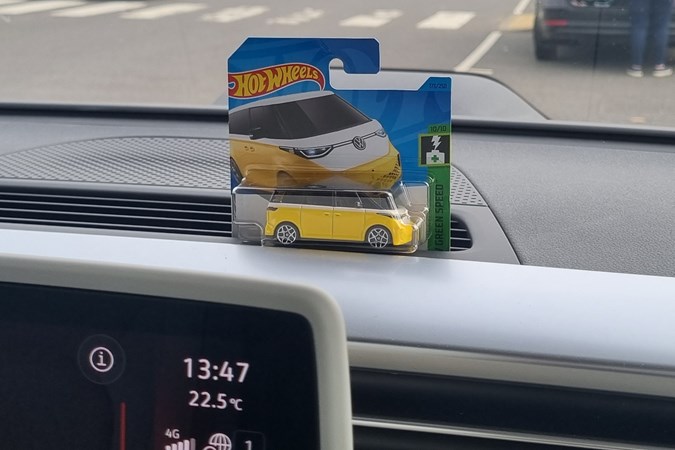
I appreciate the lofty driving position, retro-futuristic styling and oodles of space mean it’s more practical than a Skoda Octavia, but both essentially do the same thing – seat five people and a lot of luggage. It’s not even like you can properly turn the Buzz into a van thanks to the non-removable rear bench.
Once past the frustrations of the electronic nannies, I did enjoy driving the Buzz for the most part. Low speed acceleration was strong, the steering pleasant and precise, and it handled very tidily for a van. That did mean a choppy low-speed ride, while the brakes could be hard to judge.
In hindsight, I’d have avoided the optional 21-inch alloy wheels and light interior. The wheels won’t have done the ride any favours at all, and they proved far too easy to kerb. Our tally of three damaged rims is far higher than any previous test car, and the damage itself nastier. As for the beige interior, it gets grubby very quickly with a toddler on board.
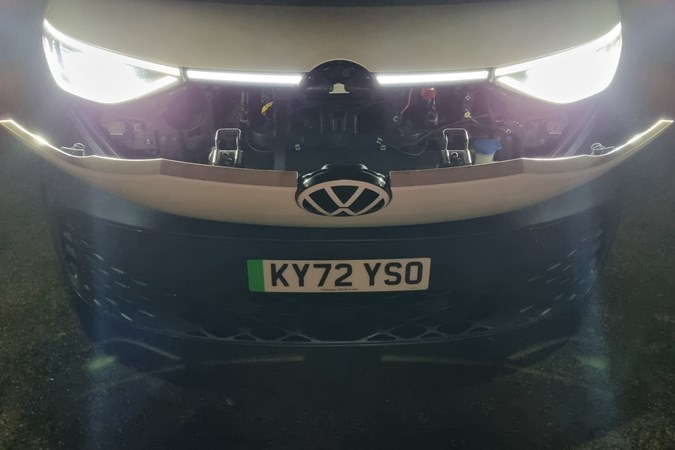
Buzz ownership certainly looks like a better prospect these days. Some cracking leasing deals means you can have the 77kWh model outside your house for around £400 a month at the time of writing. Alternatively, wait for the updated version to get seven seats, far punchier performance and a bit more range.
However, those hoping for loads of space for outdoorsy activities would be better off with something like a Peugeot Traveller. It’s even more obviously a van, but that means all the rear seats come out, and it’s cheaper to buy. If you’re fine with five seats, the Ford Transit Custom double cab in van is definitely worth a look.
In truth, most families would be served perfectly well by a smaller SUV or estate car. VW’s upcoming ID.7 Tourer will be big enough for most, go far farther on a charge, and drive better for less money. Alternatively, a Kia EV9 offers a massive boot and seating for six or seven. I’d take either over the Buzz, thanks.
Volkswagen ID.Buzz long-term test: scores on the doors
Model tested: Style SWB 77kWh Pro
| Final mileage | 4,501 |
| Real-world average efficiency | 2.4 miles per kWh |
| Official efficiency (WLTP figures) | 2.9 miles per kWh |
| Parkers ‘MPP’ (Miles Per Pound) calculation | 3.9-4.5 mpp |
| Dates tested by Parkers | September 2023-April 2024 |



